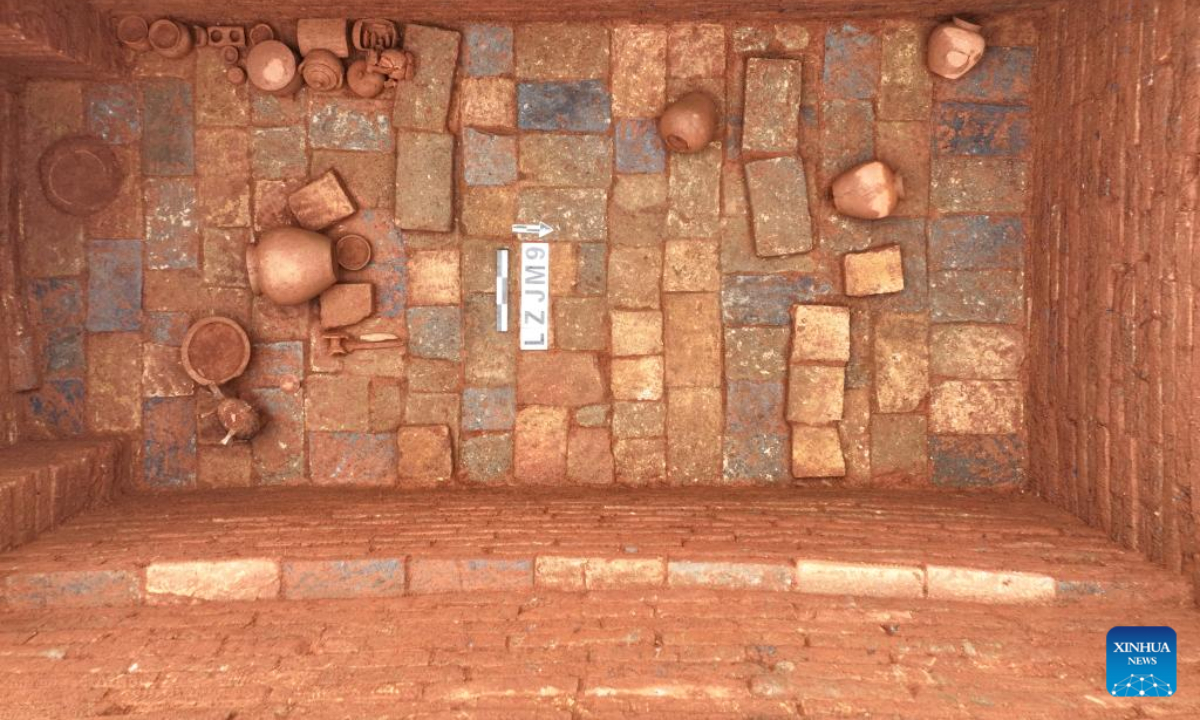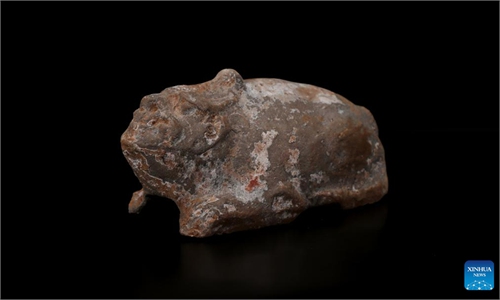ARTS / CULTURE & LEISURE
New museum in East China to show visitors original Han Dynasty tombs

Aerial photo taken on June 28, 2022 shows the cultural relics unearthed in a tomb complex in the city of Leiyang in central China's Hunan Province. Archaeologists have found 14 tombs dating back to between the Eastern Han Dynasty (25-220) and the Tang Dynasty (618-907). Photo:Xinhua
A new museum will be built on the excavation site of two ancient Han tombs in Jiyang, East China's Shandong Province, where visitors can enter the tomb chamber through a walkway and study the famous original stone carvings of the Han Dynasty (206BC-AD220).
According to Jiyang News, the Han tomb ruins site is located in Sanguanmiao village, Jiyang. As the project is nearing completion, the Jiyang Sanguanmiao Han Tombs Museum will open to the public very soon.
"The archaeological excavation of the Sanguanmiao Han tombs is a major archaeological discovery in Jiyang in recent years," a museum staffer told the local news.
"The stone carvings inside the Jiyang Sanguanmiao Han tombs site are large in scale, well preserved, rich in themes and exquisitely made," Zhang Tingting, a Sichuan-based historian who specializes in Han culture, told the Global Times, adding that the site is a rare new discovery related to the Han Dynasty in the province in recent years, which has attracted wide attention and an enthusiastic response from society.
According to the local news, the exhibition hall of the Sanguanmiao Han Tombs Museum covers an area of about 4,200 square meters. The museum has a bright and warm overall tone, the person in charge said to the local media.
The new museum will be divided into four parts. The first part mainly displays archaeological excavation achievements such as the cultural relics and rubbings unearthed from the Sanguanmiao Han Tombs; the second part is a historical exhibition, which mainly tells how the Han Dynasty achieved unification and how it made the concept of "great unity" deeply rooted in people's hearts.
The third part will present cultural relics, and the fourth will host temporary exhibitions.
The Sanguanmiao site in Shandong was selected as one of the five new archaeological discoveries in Shandong province in 2019. The site contains two of the largest Han stone carving tombs ever found, with hundreds of exquisite stone carvings that make the ancient tomb stand out.
One of the tombs, M1, has a special structure with a double tomb passage and multiple chambers. It faces north and south, and has a large scale. The whole tomb chamber is equivalent to a modern four-room and two-hall house.
Experts say that Jiyang, as a plain area north of the Yellow River, has scarce stone materials. Both the large-scale tomb and the numerous and beautiful stone carvings indicate that the tomb owner was either a high-ranking official or from a wealthy family.
Wang Shougong, director of the Cultural Relics Protection and Archaeology Department of Shandong Provincial Bureau of Cultural Relics, said that the next step for the Sanguanmiao Han Tombs is to protect it as a whole.
"First of all, we will protect the Sanguanmiao Han Tombs with our best efforts. Since the groundwater level is high where the Han Tomb is located, the local government has spent more than 5 million yuan to isolate the Han Tomb from groundwater," Wang said.
In addition to building a museum on the site of the Sanguanmiao Han Tombs, a characteristic agricultural ecological park will be built with the museum as the core, creating a cultural tourism integration project.
"Han tomb culture is an important part of ancient Chinese burial culture, which reflects the social system, economic situation, religious beliefs, artistic style, and ethnic exchanges of the Han dynasty," noted Zhang, adding that the scale and structure of the Han tombs show the social hierarchy of the Han dynasty.
A special type of burial item in the Han dynasty, stone carvings can be seen in various patterns and texts, sometimes covering an entire tomb passage or chamber or forming a series of murals.
The themes of stone carvings are very rich, including myths and legends, historical stories, portraits, animals and plants and daily life, recording the cultural thoughts and customs of the Han Dynasty.


